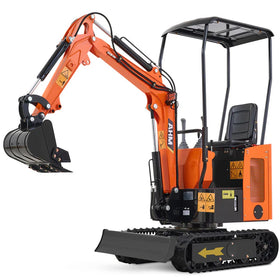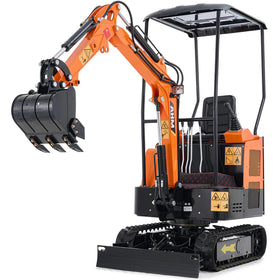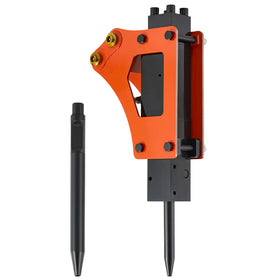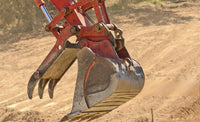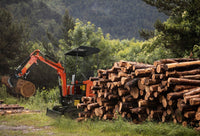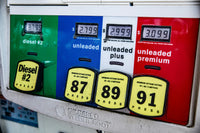Mini excavators pack serious digging power into a compact frame, but the engine inside makes all the difference in how well they perform on your jobsite. Choosing between a V-Twin or 3-cylinder engine affects everything from your daily fuel costs to how quickly you finish jobs. This guide cuts through the sales talk to show what actually matters in the real world, based on what contractors and operators experience every day on the job. We've broken down the practical differences to help you select the right machine for your specific work needs and budget goals.

Quick Comparison: V-Twin vs. 3-Cylinder Engines
|
Feature |
V-Twin (2-Cylinder) Engines |
3-Cylinder Engines |
|
Initial Cost |
Lower upfront cost (8-15% less) |
Higher purchase price |
|
Power Delivery |
More responsive but can feel "jumpy" |
Smoother, more consistent power |
|
Best Applications |
Small residential jobs, landscaping, frequent transport between sites |
Commercial projects, utility work, extended digging operations |
|
Fuel Efficiency |
Uses less fuel per hour but may use more per job completed |
Higher hourly consumption but often lower cost per job |
|
Maintenance Intervals |
Oil changes every 250-300 hours |
Oil changes every 500 hours |
|
Common Issues |
Overheating under sustained load |
More complex fuel systems requiring specialized repair |
|
Noise Level |
Louder, higher-pitched sound |
Quieter, lower-frequency operation |
|
Cold Weather Performance |
Longer warm-up times |
Better cold starting, faster warm-up |
|
Emissions Compliance |
Fewer models meeting latest Tier 4 standards |
Most new models fully Tier 4 compliant |
|
Resale Value |
Lower trade-in value |
Typically 10-15% higher resale value |
1. Understanding Engine Types in Mini Excavators
1.1 Common Engine Configurations
Mini excavators typically come with either a 2-cylinder or 3-cylinder diesel engine. The 2-cylinder engines (often called V-Twin when arranged in a V configuration) have been the traditional workhorses of smaller machines, while 3-cylinder engines offer additional power for more demanding applications.
When operators talk about V-Twin engines, they're referring to a 2-cylinder engine where the cylinders are arranged in a V-shape rather than in a line. This configuration helps reduce vibration and allows for a more compact design. You might see these referenced as "V2" engines in some technical documentation, but they're the same thing—no need to get confused by the different terminology.

1.2 The Real Impact of Cylinder Count
The number of cylinders affects several aspects of performance that directly impact your work:
- Power Delivery: 3-cylinder engines generally provide smoother power delivery compared to 2-cylinder options. This translates to less lurching during precision work and more consistent performance when the engine is under load.
- Torque Characteristics: 2-cylinder engines often deliver strong low-end torque, which is beneficial for digging operations. 3-cylinder engines typically offer better torque throughout the RPM range, making them more versatile for various applications.
- Fuel Efficiency: While many assume more cylinders mean higher fuel consumption, modern 3-cylinder engines often incorporate advanced fuel management systems that can actually deliver better fuel economy than older 2-cylinder designs when matching power output.
As one rental fleet manager told me, "We used to exclusively buy machines with 2-cylinder engines because they were simpler and cheaper. But we've found that the additional investment in 3-cylinder machines pays for itself through better reliability and less downtime, especially on longer-term jobs."
2. Matching Engines to Your Specific Applications
2.1 Residential and Landscaping Work

For residential contractors and landscapers working in tight spaces with neighbors nearby, engine choice significantly impacts your success:
- Noise Considerations: 3-cylinder engines typically run at lower RPMs to achieve the same power output as 2-cylinder engines, resulting in quieter operation—a crucial factor when working in residential areas with noise restrictions.
- Precision Control: When you're working around existing utilities or finished landscapes, the smoother power delivery of a 3-cylinder engine provides better control for delicate work.
- Weight Factors: If you're frequently moving between jobsites or working on sensitive surfaces like finished lawns, the additional weight of a larger engine needs to be balanced against power requirements. Some newer 2-cylinder engines with turbochargers offer a good compromise here.
2.2 Commercial Construction Applications

On commercial sites, productivity often takes precedence over other factors:
Sustained Performance:
3-cylinder engines typically handle extended operation under heavy load better than their 2-cylinder counterparts. When you're spending full days excavating foundations or trenching, this sustained performance becomes critical.
Altitude Adaptability:
If you work in higher elevations, 3-cylinder engines often maintain performance better due to their additional displacement and power reserve.
Cold Weather Starting:
Larger 3-cylinder engines generally provide more reliable cold-weather starting, reducing delays on winter job sites. However, newer 2-cylinder engines with improved glow plug systems have narrowed this gap significantly.
2.3 Utility Work and Infrastructure Projects
For utility contractors working on water, sewer, or electrical infrastructure:
Cycle Time Impact:
Engine power directly affects cycle times when trenching. A more powerful 3-cylinder engine can reduce the time needed to complete a full dig and dump cycle, potentially increasing daily production by 15-20%.
Extended Idling Performance:
Utility work often involves periods of idling while waiting for inspections or coordinating with other trades. Modern 3-cylinder engines typically handle extended idling better, with less carbon buildup and related maintenance issues.
3. Real-World Performance Comparison
When comparing actual performance rather than just specifications, several key differences emerge:
3.1 Power Delivery Characteristics
A 2-cylinder V-Twin engine (like those commonly found in Takeuchi or older Kubota mini excavators) delivers power differently than a 3-cylinder inline engine (common in newer Kubota, Caterpillar, and Yanmar models):
Throttle Response:
2-cylinder engines often have more immediate throttle response, which some operators prefer for precise movements. 3-cylinder engines typically provide more progressive power delivery, which can be easier to control for less experienced operators.
Under-Load Performance:

When digging in dense clay or rocky soil, 3-cylinder engines generally maintain more consistent RPMs, resulting in smoother bucket movement and less stalling.
You can feel the difference immediately when switching between machines. The 2-cylinder machines can feel jumpy if you're not used to them, but they're responsive when you need immediate power. The 3-cylinders feel more like operating a larger machine—more predictable and less prone to bogging down when you hit something unexpected.
3.2 Parallel Twin vs. V-Twin Configuration
Some 2-cylinder engines have cylinders side-by-side (parallel) while others arrange them in a V shape. This makes a big difference when you use the machine daily:
Less Shaking, Less Pain: V-Twins shake a lot less than parallel twins. This matters when you're in the cab for 8 hours straight. Many operators complain about sore backs, stiff necks, and tingling hands after long days in machines with parallel twins. The V-Twin setup cuts down on this.
Easier Fixes: Parallel twins make it easier to reach oil filters and fuel filters for quick service. But V-Twins give better access to parts that break more often in older machines, like injectors. This can save hours on repairs, especially in the field.
Better in Hot Weather: V-Twins cool down better when it's hot outside. This means fewer shutdowns on those 90-degree summer days when you're trying to finish a job.
Worth More Later: Used equipment buyers often pay more for V-Twin machines. They know these engines handle tough jobs better over time.
Starts Faster in Winter: V-Twins warm up more evenly in cold weather. This gets you working sooner on cold mornings instead of waiting for the machine to be ready.
4. The Real Costs of Engine Choice
4.1 Purchase Price vs. Long-Term Value
The engine type affects what you pay now and what you earn later:
Upfront Costs: 3-cylinder mini excavators cost about 8-15% more than similar 2-cylinder models. For a $30,000 machine, that means paying $2,400 to $4,500 extra upfront.
Trade-in Value: 3-cylinder machines hold their value better over time. After 5 years, a 3-cylinder mini excavator often sells for 10-15% more than a comparable 2-cylinder model with the same hours.
Lifetime Operating Costs: The total cost difference goes beyond the purchase price. A typical mini excavator works about 800-1,000 hours per year. Over a 5-year period, mini excavator engine choice affects your bottom line by thousands of dollars through fuel use, downtime, and maintenance needs.
4.2 Fuel Use and Productivity
Cylinder count affects how much fuel you use to get a job done:
Fuel per Job vs. Fuel per Hour: 3-cylinder engines use more fuel per hour but finish jobs faster. On typical trenching projects, 3-cylinder machines use about 10% more fuel but complete jobs 15-20% faster, resulting in lower overall fuel costs per project.
Fuel Consumption Under Load: 2-cylinder engines need higher RPMs to handle tough digging in clay or rocky soil. This higher RPM operation burns more fuel when the going gets tough, often using 20-30% more fuel per cubic yard moved in difficult soil.
Idle Time Efficiency: On jobs with lots of stopping and waiting (utility work, residential projects with inspections), 3-cylinder engines typically burn less fuel at idle, saving 5-8% in total fuel costs on these types of projects.
5. Keeping Your Mini Excavator Running: Maintenance Reality

5.1 Service Schedules and Costs
Engine type directly affects how often you'll be doing maintenance and what it costs:
Oil Change Timing: 3-cylinder engines typically need oil changes every 500 hours. Most 2-cylinder engines need oil changes every 250-300 hours. This means almost twice as many oil changes for 2-cylinder machines over their lifetime.
Parts and Labor Costs: Annual maintenance for a 2-cylinder mini excavator averages $1,200-1,800. For 3-cylinder machines, expect to pay $1,500-2,200 per year. The higher cost for 3-cylinder engines is offset by less frequent service.
Filter Replacement: Getting to the filters on V-Twin engines can be harder than on 3-cylinder models. This often adds 15-20 minutes to each service, increasing labor costs slightly.
5.2 What Breaks and Why
Knowing common problems helps you prevent costly downtime:
Heat Problems in 2-Cylinder Engines: 2-cylinder engines tend to overheat when working hard all day, especially in hot weather. This mainly happens in older models. Watch your temperature gauge when digging tough material for long periods.
Cooling System Issues: 2-cylinder machines have simpler cooling systems that need more attention. Check radiator fins weekly for dirt and debris buildup.
Injection System Complexity: 3-cylinder engines have more advanced fuel systems. When these have problems, repairs often require dealer service. Most local mechanics can handle 2-cylinder repairs, but might struggle with newer 3-cylinder systems.
Starter Motor Life: 2-cylinder engines tend to need starter replacement every 2,000-2,500 hours. 3-cylinder starters typically last 3,000-3,500 hours due to more balanced engine loading.
Glow Plug Failures: In cold climates, 2-cylinder engines need glow plug replacement more often. Budget for replacement every 800-1,000 hours, compared to about 1,200-1,500 hours for 3-cylinder engines.
6. Meeting Rules and Keeping Neighbors Happy
6.1 Emissions Standards Matter
Newer rules about exhaust can affect which machines you can use:
Tier 4 Rules: Most new 3-cylinder engines meet the latest Tier 4 standards. Many older 2-cylinder engines don't. This matters because:
Job Site Restrictions: More cities now require Tier 4 equipment on municipal jobs. Some even check emissions on private jobs in urban areas.
Future Bidding: If you're buying a machine to use for 5+ years, consider that more jobs will require cleaner engines. A 3-cylinder Tier 4 machine may cost more now but keep you eligible for more jobs later.
Resale Territory Limits: Non-compliant machines can't be sold in some states or cities, shrinking your buyer pool when it's time to upgrade.
6.2 Noise Levels and Work Hours
How loud your machine is affects when and where you can work:
Actual Noise Difference: 3-cylinder engines typically run 3-5 decibels quieter than 2-cylinder engines at the same power output. This small difference matters a lot for noise complaints.
Working Near Homes: When working in residential areas, a quieter 3-cylinder machine may let you start earlier and finish later under local noise rules. This can add 1-2 productive hours to each day.
Sound Character Matters: 3-cylinder engines produce a deeper, less annoying sound than the higher-pitched noise from 2-cylinder engines. Neighbors complain less about lower-frequency engine noise, even at similar volume levels.
Enclosed Cabs Help: Newer models often have better sound insulation in the engine compartment. This feature exists on both engine types but helps more with the naturally louder 2-cylinder engines.
Conclusion: Making the Right Choice for Your Business

The optimal engine for your mini excavator depends on an honest assessment of your typical work:
- For contractors primarily doing residential work with frequent transport between job sites, a well-designed 2-cylinder engine might offer the best balance of weight, power, and cost.
- For commercial contractors with sustained heavy digging requirements, the additional investment in a 3-cylinder engine typically pays dividends through improved productivity and reduced downtime.
- For fleet operators, the maintenance simplicity of a consistent engine type across multiple machines often outweighs marginal performance differences between engine configurations.
Rather than focusing on technical specifications alone, consider how the engine's characteristics align with your specific applications, operator preferences, and business economics. The right engine isn't necessarily the biggest or newest—it's the one that reliably delivers the performance you need at a total cost of ownership that makes sense for your operation.
So these are the practical differences between mini excavator engines, hopefully by reading this guide you can make more informed equipment decisions that directly impact your productivity, operating costs, and ultimately, your profitability.
FAQ: V-Twin vs 3-Cylinder Mini Excavator Engines
Q1: What’s the main difference between V-Twin and 3-cylinder engines?
A1: Great question! A V-Twin engine has two cylinders arranged in a V shape and delivers quick responses but the power can feel a bit jumpy. On the other hand, a 3-cylinder engine provides smoother, more consistent power, making it great for longer, heavier jobs.
Q2: Which engine is more fuel-efficient?
A2: The V-Twin typically uses less fuel per hour. However, because 3-cylinder engines deliver power more efficiently, they can end up saving fuel over the course of a full day’s work.
Q3: Are there any differences in maintenance?
A3: Yes! V-Twin engines usually need oil changes more often, around every 250-300 hours, while 3-cylinder engines can go longer between changes—around 500 hours. But keep in mind, 3-cylinder engines might have more complex fuel systems that could cost more to repair.
Q4: How do these engines perform in cold weather?
A4: 3-cylinder engines generally start up quicker and preheat faster in cold weather. V-Twin engines take a bit longer to warm up but run smoothly once they're ready.
Q5: Which engine should I choose for my work?
A5: If you’re doing lighter residential jobs or moving around a lot, a V-Twin engine is economical and practical. For commercial jobs or heavy-duty, all-day work, a 3-cylinder engine offers more reliable, robust power.
Q6: Which engine runs quieter?
A6: The 3-cylinder engine tends to run quieter and with a deeper sound, while the V-Twin makes a sharper, louder noise.
Q7: What about resale value?
A7: Because 3-cylinder engines often have newer technology and longer durability, their resale value tends to be 10-15% higher than V-Twin engines.


